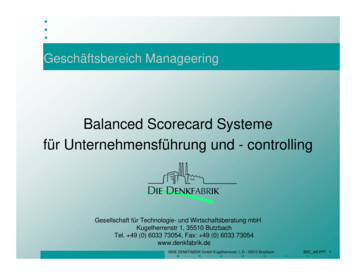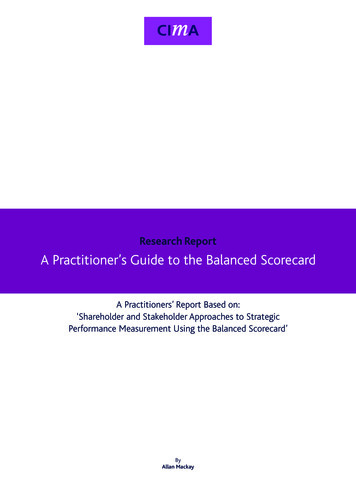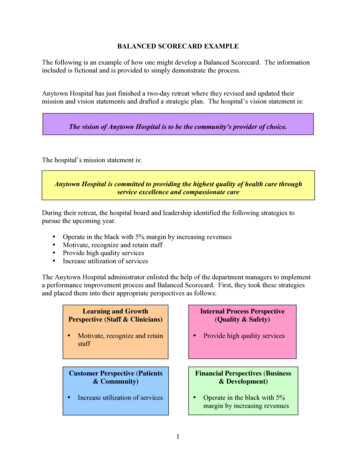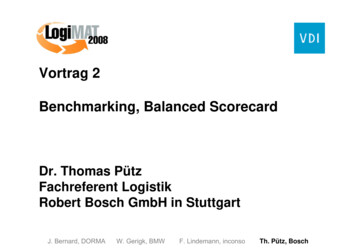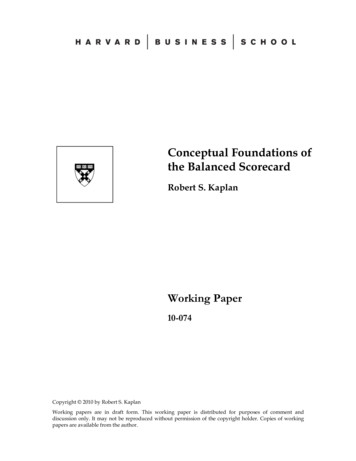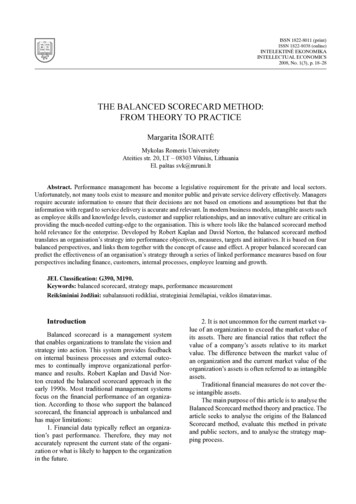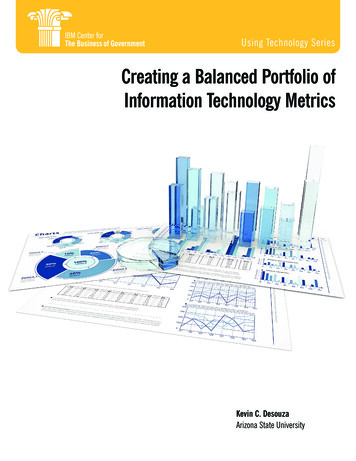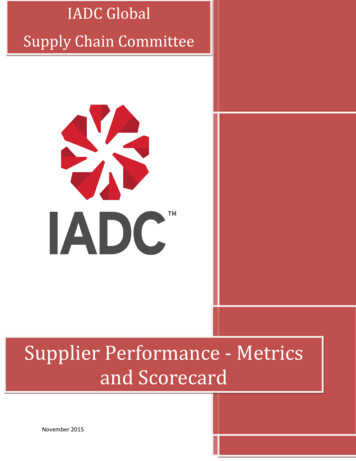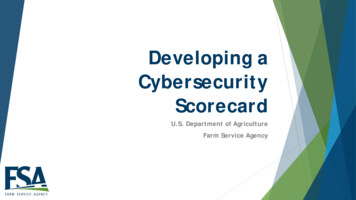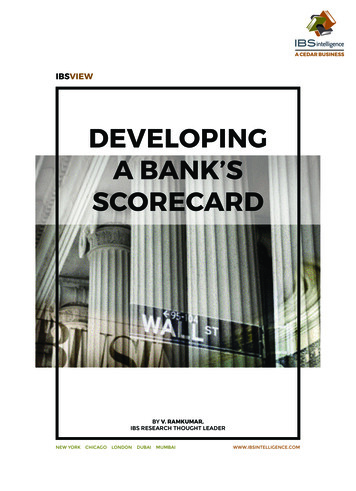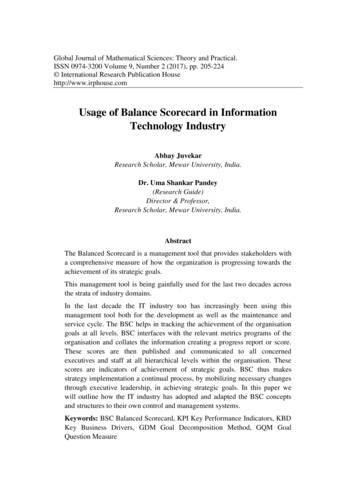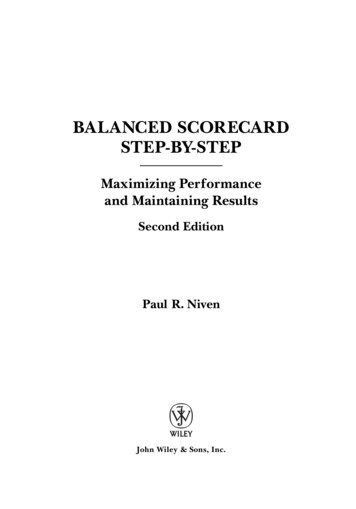
Transcription
fm.qxd07/06/0602:04 PMPage iiiBALANCED SCORECARDSTEP-BY-STEPMaximizing Performanceand Maintaining ResultsSecond EditionPaul R. NivenJohn Wiley & Sons, Inc.
fm.qxd07/06/0602:04 PMPage ii
fm.qxd07/06/0602:04 PMPage iBA LANCED SCORECARDSTEP-BY-STEP
fm.qxd07/06/0602:04 PMPage ii
fm.qxd07/06/0602:04 PMPage iiiBALANCED SCORECARDSTEP-BY-STEPMaximizing Performanceand Maintaining ResultsSecond EditionPaul R. NivenJohn Wiley & Sons, Inc.
fm.qxd07/06/0602:04 PMPage ivThis book is printed on acid-free paper. Copyright 2006 by John Wiley & Sons, Inc. All rights reserved.Published by John Wiley & Sons, Inc., Hoboken, New Jersey.Published simultaneously in Canada.No part of this publication may be reproduced, stored in a retrieval system,or transmitted in any form or by any means, electronic, mechanical,photocopying, recording, scanning, or otherwise, except as permitted underSection 107 or 108 of the 1976 United States Copyright Act, without eitherthe prior written permission of the publisher, or authorization through paymentof the appropriate per-copy fee to the Copyright Clearance Center, Inc.,222 Rosewood Drive, Danvers, MA 01923, 978-750-8400, fax 978-646-8600,or on the web at www.copyright.com. Requests to the publisher for permissionshould be addressed to the Permissions Department, John Wiley & Sons, Inc.,111 River Street, Hoboken, NJ 07030, 201-748-6011, fax 201-748-6008, oronline at http://www.wiley.com/go/permissions.Limit of Liability/Disclaimer of Warranty: While the publisher and authorhave used their best efforts in preparing this book, they make no representationsor warranties with respect to the accuracy or completeness of the contents ofthis book and specif ically disclaim any implied warranties of merchantability orf itness for a particular purpose. No warranty may be created or extended bysales representatives or written sales materials. The advice and strategies containedherein may not be suitable for your situation. You should consult with a professionalwhere appropriate. Neither the publisher nor author shall be liable for any lossof prof it or any other commercial damages, including but not limited to special,incidental, consequential, or other damages.For general information on our other products and services, or technicalsupport, please contact our Customer Care Department within the United Statesat 800-762-2974, outside the United States at 317-572-3993 or fax 317-572-4002.Wiley also publishes its books in a variety of electronic formats. Some contentthat appears in print may not be available in electronic books.For more information about Wiley products, visit our Web site at www.wiley.com.Library of Congress Cataloging-in-Publication DataNiven, Paul R.Balanced scorecard step-by-step : maximizing performanceand maintaining results / Paul R. Niven. — 2nd ed.p. cm.Includes index.ISBN-13: 978-0-471-78049-6 (cloth)ISBN-10: 0-471-78049-9 (cloth)1. Organizational effectiveness — Measurement.2. Performance — Measurement. I. Title.HD58.9.N58 2006658.4'013 — dc22Printed in the United States of America109876543212006008526
fm.qxd07/06/0602:04 PMPage vThis being a second edition it seems f itting thatI dedicate the book to my “second parents,” my wife’smother and father, Harry and Pat Ackstein.Thank you both for your love, generosity, and support.
fm.qxd07/06/0602:04 PMPage vi
fm.qxd07/06/0602:04 PMPage viiAbout the AuthorPaul R. Niven is a management consultant and noted speaker on the subjects of performance management and the Balanced Scorecard. As botha practitioner and consultant he has developed successful performancemanagement systems for organizations large and small around the globe.His clients include Fortune 500 companies, public sector agencies fromall levels, and nonprofit organizations. He may be reached through his Website at www.senalosa.com.vii
fm.qxd07/06/0602:04 PMPage viii
fm.qxd07/06/0602:04 PMPage ixContentsPrefacexiAcknowledgmentsChapter 1xviiPerformance Measurement and theNeed for a Balanced Scorecard1Chapter 2Getting Started31Chapter 3Mission, Values, Vision, and Strategy71Chapter 4Strategy Maps97Chapter 5Creating Performance Measures143Chapter 6Setting Targets and Prioritizing Initiatives179Chapter 7Cascading the Balanced Scorecardto Build Organizational Alignment199Using the Balanced Scorecard toStrategically Allocate Resources221Additional Balanced Scorecard Linkages:Compensation and Corporate Governance239Chapter 10Reporting Balanced Scorecard Results261Chapter 11Maintaining the Balanced Scorecard281Chapter 12Concluding Thoughts on BalancedScorecard Success299Index311Chapter 8Chapter 9ix
fm.qxd07/06/0602:04 PMPage x
fm.qxd07/06/0602:04 PMPage xiPrefaceFour years ago I wrote Balanced Scorecard Step-by-Step to provide a systematicimplementation guide to readers incorporating or considering incorporating the Balanced Scorecard methodology in their organization. My experiences as a Balanced Scorecard practitioner with a large Canadian companytaught me that tremendous results are possible with the tool, but to attainthose results, you must overcome numerous pitfalls that can derail or signif icantly damage the implementation effort. I have been amazed andhumbled at the success of the first edition, which has now been translated inover a dozen languages. The many e-mails, calls, and letters I have receivedfrom readers who have benef ited in some way from the guidance offeredin the book have been very gratifying and demonstrate that, with a littlehelp, every organization can derive tremendous success from the BalancedScorecard system.This second edition contains the same core implementation guidancefound in the original volume but has been updated and enhanced to includeguidance on a number of topics that were still relatively immature as ofthe f irst printing in 2002. The most signif icant change is my expandedcoverage of strategy maps, powerful communication tools signaling to theentire workforce (and beyond) what is critical in executing the organization’s strategy. The text also provides new and updated information onthe linkage between the Balanced Scorecard and corporate governance,the critical importance of strategy-centered management meetings, andan emerging trend, the Off ice of Strategy Management. In addition toentirely new sections, you will f ind the latest thinking on all aspects ofthe Balanced Scorecard journey, honed from my work as a consultant andresearcher.THE BALANCED SCORECARDOrganizations in today’s change-f illed, highly competitive environmentmust devote signif icant time, energy, and human and f inancial resourcesto measuring their performance in achieving strategic goals. Most do justthat, but despite the substantial effort and related costs, many are dissatisfied with their measurement efforts. In fact, at any given time, as manyxi
fm.qxd07/06/06xii02:04 PMPage xiiPrefaceas 50 percent of organizations are making changes to their performancemeasurement systems.1Increasingly, organizations are concluding that while measurement ismore crucial than ever, their systems for capturing, monitoring, and sharing performance information are critically flawed. Today’s systems in manyways bear a remarkable resemblance to their reporting ancestors. Althoughthe methods of modern business have transformed dramatically over thedecades, our systems of measurement have remained f irmly mired in thepast. At the root of our measurement misery is an almost exclusive relianceon f inancial measures of performance. These systems may have been perfectly suited to the machinelike, physical asset–based nature of early industrialendeavors, but they are ill-equipped to capture the value-creating mechanisms of today’s modern business organization. Intangible assets such asemployee knowledge, customer and supplier relationships, and innovativecultures are the key to producing value in today’s economy. Additionally,the importance of a differentiating strategy is more important today thanit has ever been. Whether you’re a high-tech newcomer or an establishedmanufacturing veteran, executing strategy effectively is crucial in an eraof globalization, customer power, and rapid change. But the sobering factis that about 9 out of 10 organizations fail to implement their strategies.What is needed is a measurement system that balances the historical accuracy and integrity of f inancial numbers with today’s drivers of economicsuccess, and in so doing allows the organization to beat the odds of executingstrategy.The Balanced Scorecard has emerged as a proven and effective tool inour quest to capture, describe, and translate intangible assets into realvalue for all of an organization’s stakeholders and, in the process, to alloworganizations to implement their differentiating strategies successfully.Developed by Robert Kaplan and David Norton, this deceptively simplemethodology translates an organization’s strategy into performance objectives, measures, targets, and initiatives in four balanced perspectives:Financial, Customer, Internal Process, and Employee Learning and Growth.Organizations around the globe have embraced the Balanced Scorecardand reaped swift benef its from its commonsense principles. Such benef its include increased f inancial returns, greater employee alignment withoverall goals, improved collaboration, and an unrelenting focus on strategy,to name just a few. To reap those rewards, however, an organization mustpossess the tools necessary to craft an effective Balanced Scorecard.1 . Mark L. Frigo, “The State of Strategic Performance Measurement,” IMA 2001Survey.
fm.qxd07/06/0602:04 PMPage xiiiPrefacexiiiAbout This BookIn the mid-1990s I was working with an organization that, like so manyothers, was about to undergo significant change. The industry structure waschanging, competitors appeared more nimble and threatening than ever,and customers were demanding better service with no price increases. Anew strategy was developed that, if effectively implemented, would see theorganization enhance employee skills, develop new processes, build customer loyalty, and ultimately deliver breakthrough f inancial performance.But how could the strategy be executed successfully? The organization’schief f inancial off icer investigated the Balanced Scorecard approach anddetermined it was the right tool at the right time. Acting as the executivesponsor for the initiative, he appointed me to lead a team charged withthe responsibility for developing a new management system featuring theBalanced Scorecard as the cornerstone. Two years later his intuition paidoff in a big way. Employee knowledge of strategy had increased signif icantly, internal processes were functioning more eff iciently than ever, customer loyalty was on the rise, and despite many adverse factors beyond theorganization’s control, f inancial returns were on target.The organization just described is Nova Scotia Power, Inc. (NSPI), aCanadian electric utility company. As the results demonstrate, its BalancedScorecard implementation was a great success and has been featured in casestudies and shared at conferences throughout North America and beyond,and has earned the organization a spot in the Balanced Scorecard Collaborative’s Hall of Fame. As successful as the implementation was, however,it was not without challenges. Our team quickly learned that building aBalanced Scorecard is far more than a metrics project; instead it touchesmany disparate organizational processes. Building an effective team; generating support and enthusiasm for a change initiative; efficiently gatheringand sharing data; and coaching, training, and facilitating are just some ofthe many exciting and challenging tasks we faced. At that time, BalancedScorecard literature and support services were at a nascent stage, and wewere left to our own devices when grappling with the many issues awaiting us. Although Scorecard literature and related consulting and supportproducts have proliferated in recent years, few if any focus on the wide arrayof organizational activities that must accompany a winning Scorecard campaign. This book has been written to fill the void existing between theoryand application. Since its original publication in 2002, it has guided thousands of organizations worldwide through their Balanced Scorecard journeys.Organizations embarking on a Scorecard effort must be aware of — andproperly equipped with the tools to navigate successfully— the many potential pitfalls associated with an initiative of this magnitude. Based on myexperience as a consultant working with organizations around the globeplus extensive research, these pages guide the reader through the entire
fm.qxd07/06/0602:04 PMPage xivxivPrefaceBalanced Scorecard process on a step-by-step basis. From determining yourguiding rationale for the Scorecard, to testing your mission, to buildinga Strategy Map, to developing measures and targets, to placing the Scorecard at the center of your management system, to tips for sustaining yoursuccess, you’ll f ind all this and more. Let’s now take a look at how the bookis organized and consider how you can use it to best suit your needs.How the Book Is OrganizedThis second edition of Balanced Scorecard Step-by-Step is comprised of12 chapters, spanning the entire Scorecard experience. The opening chapter is designed to familiarize you with the f ield of performance measurement and provide a solid grounding of Scorecard background andprinciples. It elaborates on the discussion begun in this preface by examining how the Scorecard solves three fundamental modern business issues:reducing the reliance on financial performance measures, the rise of intangible assets to value creation, and the diff iculty of implementing strategy.Chapter Two lays the foundation for the work ahead by examining thepurpose of developing a Balanced Scorecard, securing executive sponsorship, creating a team, and preparing a developmen
support, please contact our Customer Care Department within the United States at 800-762-2974, outside the United States at 317-572-3993 or fax 317-572-4002. Wiley
